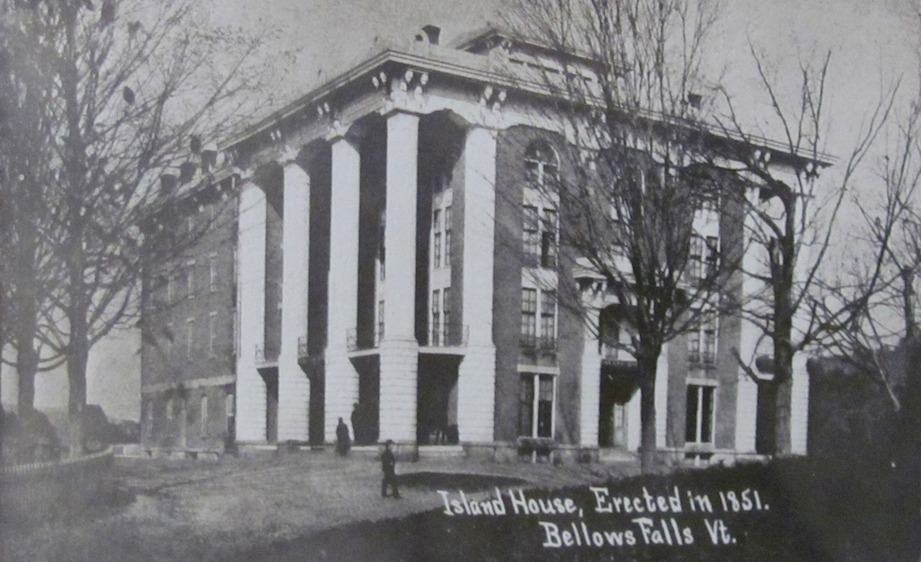
Here’s a selection from Lyman Hayes’ 1929 book, “The Connecticut River Valley of Southern Vermont and New Hampshire.” I found his description of the grounds and gardens just wonderful. Island House was destroyed by fire Aug. 14, 1907.
“Until a comparatively recent time, people approaching Bellows Falls from the north or south observed as a prominent feature of the landscape a stately building on the highest point of the island, a large brick building with high white pillars, which had, since its erection in 1849, been a prominent feature of the business life of Bellows Falls. It was the ‘Island House’ building which from 1849 until about 1868 was one of the most popular hotels of the Connecticut valley, patronized before the Civil War by an extremely wealthy class of people from the South, on their way to and from the White Mountains, and as a summer hotel. It was the scene of many social triumphs and the home of both beauty and greatness.

“Until the first named year it had been the site of one of the best dwellings of the village, built about 1792 by Dr. Samuel Cutler, occupied by him, and later by his son-in-law Rector Carlton Chase, who was later Episcopal Bishop of New Hampshire. In 1849-50 Col. Roswell Shurtleff remodeled the old building for a hotel and it was destroyed by fire before being opened. The Colonel then erected the present four-story brick structure, as the railroads were then just being built into the village from four different directions. For years it was a noted success, drawing a high grade of patronage from wide areas. The Civil War caused a loss of that class of patronage.
“Early in its history much money was expended on its surroundings and in providing excursions and entertainment hall for its guests. Col. Shurtleff owned nearly all of the land on the island. He had two bowling alleys near where the present office of the Vermont Machine Co. is, and the frame building across the street, recently occupied as the Fall Mountain House [now vacant], was erected for an entertainment hall that saw many scenes of gaiety and festivity. For some years it was the largest and best public hall in the village. The stables and extensive gardens and greenhouses were in the rear of the hotel building, on land now covered by the works of the Robertson Paper Co. and the Co-operative Creamery, while across Bridge Street in front and on the two sides were parks with fountains and statuary. A beautiful grove of pines extended over the whole length of the rocky river bank opposite the falls.
“A good carriage road was built to the summit of Mount Kilburn and a sightly picnic and observation house built on Table Rock could be seen for many miles up and down the Connecticut, with its Grecian architecture and its white pillars. All during the summer season, carriages took guests twice each day to the top of the mountain, and also to be noted Abenauqui mineral spring two miles south on the New Hampshire side of the river.
“The decline of the summer business late in the ‘60s and in the ‘70s led to a gradual sale of the property surrounding the house on the island. Manufactories crept in, the branch railroad to the mills was built along the river bank, destroying its picturesqueness, and the managers lost money each year. As a result, it was closed as a hotel in the fall of 1887, and the main part of the building has been for several years a part of the buildings of the Vermont Farm Machine Co., occupied largely for storage.
“The hotel was at different times the abiding place of a number of eminent people. President Ulysses S. Grant was a guest, and spoke to a large concourse of people from the balcony over the south door, on August 7, 1869. The veteran General W.T. Sherman spoke from the same balcony July 23, 1869. On October 3, 1853, the Ancient and Honorable Artillery of Boston had a noted banquet within its walls, and of the fragments that remained of the feast on the next day there were picked up six hundred and fifty bottles, the contents of which had contributed to the conviviality of the occasion. The bill of fare for that occasion, of which there is still one in existence, is one of the most extensive, and beautifully printed, of any similar occasion of its kind known to have been held here.”
“Fate favors the prepared mind.”